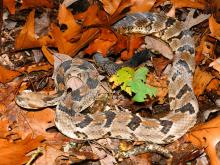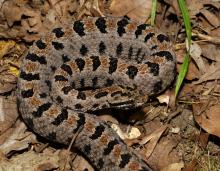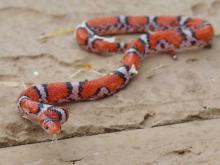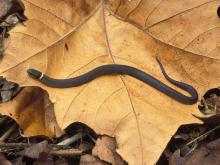Reptiles and Amphibians
Media

Species Types
Scientific Name
Crotalus horridus
Description
Missouri’s largest venomous snake, the timber rattlesnake, is dangerously venomous, but there are few cases of rattlesnake bites in our state. It frequents rough country, is mostly nocturnal in summer, and few Missourians ever encounter it.
Media

Species Types
Scientific Name
Sistrurus miliarius streckeri
Description
The western pygmy rattlesnake is small and colorful, with a slender tail and tiny rattle. Its vibrating rattle is a faint buzz that sounds like a grasshopper. In Missouri, it occurs in the eastern Ozarks and in some counties bordering Arkansas.
Media

Species Types
Scientific Name
Agkistrodon contortrix
Description
The eastern copperhead is the most common venomous snake in Missouri. Its color varies from grayish brown to pinkish tan, with distinctive hourglass-shaped crossbands.
Media

Species Types
Scientific Name
Farancia abacura reinwardtii
Description
The western mudsnake is a harmless swamp dweller of Missouri's Bootheel lowlands. It is burdened with misinformation and imaginative folklore. But it turns out that fact is more interesting than fiction.
Media

Species Types
Scientific Name
Thamnophis proximus proximus
Description
The orange-striped ribbonsnake is a type of gartersnake named for the attractive orange or yellow stripes running the length of its body, alternating with wide black stripes. It is found statewide, but seldom far from water.
Media

Species Types
Scientific Name
Cemophora coccinea copei
Description
One of Missouri's most brilliantly colored snakes is also extremely rare to find. The northern scarletsnake is similar in pattern and color to the more common red milksnake but has a red or orange snout and a spotless, white belly.
Media

Species Types
Scientific Name
Lampropeltis triangulum
Description
The harmless eastern milksnake is white, yellow, or light tan, with red or orange blotches bordered with black. The belly is white and strongly checked with black. This species often is misidentified as the venomous coralsnake, which is not found in Missouri.
Media

Species Types
Scientific Name
Thamnophis sirtalis sirtalis (eastern gartersnake) and T. s. parietalis (red-sided gartersnake)
Description
The eastern gartersnake and red-sided gartersnake are Missouri's most common gartersnakes. The color is variable, but there are normally three yellowish stripes, one down the back and one on each side. There are narrow black bars between the scales along the upper lip.
Media

Species Types
Scientific Name
Diadophis punctatus arnyi
Description
Prairie ring-necked snakes are easily recognizable by their small size, uniform dark color on the back, bright yellow-orange belly, and distinct yellow ring around the neck. Secretive, but common nearly statewide.
See Also
About Reptiles and Amphibians in Missouri
Missouri’s herptiles comprise 43 amphibians and 75 reptiles. Amphibians, including salamanders, toads, and frogs, are vertebrate animals that spend at least part of their life cycle in water. They usually have moist skin, lack scales or claws, and are ectothermal (cold-blooded), so they do not produce their own body heat the way birds and mammals do. Reptiles, including turtles, lizards, and snakes, are also vertebrates, and most are ectothermal, but unlike amphibians, reptiles have dry skin with scales, the ones with legs have claws, and they do not have to live part of their lives in water.





















